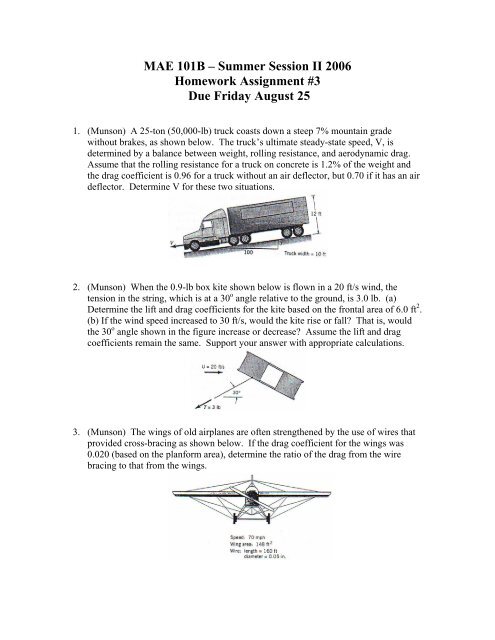Homework Assignment 3
Homework Assignment 3 Homework Assignment 3
MAE 101B – Summer Session II 2006 Homework Assignment #3 Due Friday August 25 1. (Munson) A 25-ton (50,000-lb) truck coasts down a steep 7% mountain grade without brakes, as shown below. The truck’s ultimate steady-state speed, V, is determined by a balance between weight, rolling resistance, and aerodynamic drag. Assume that the rolling resistance for a truck on concrete is 1.2% of the weight and the drag coefficient is 0.96 for a truck without an air deflector, but 0.70 if it has an air deflector. Determine V for these two situations. 2. (Munson) When the 0.9-lb box kite shown below is flown in a 20 ft/s wind, the tension in the string, which is at a 30 o angle relative to the ground, is 3.0 lb. (a) Determine the lift and drag coefficients for the kite based on the frontal area of 6.0 ft 2 . (b) If the wind speed increased to 30 ft/s, would the kite rise or fall? That is, would the 30 o angle shown in the figure increase or decrease? Assume the lift and drag coefficients remain the same. Support your answer with appropriate calculations. 3. (Munson) The wings of old airplanes are often strengthened by the use of wires that provided cross-bracing as shown below. If the drag coefficient for the wings was 0.020 (based on the planform area), determine the ratio of the drag from the wire bracing to that from the wings.
MAE 101B – Summer Session II 2006<br />
<strong>Homework</strong> <strong>Assignment</strong> #3<br />
Due Friday August 25<br />
1. (Munson) A 25-ton (50,000-lb) truck coasts down a steep 7% mountain grade<br />
without brakes, as shown below. The truck’s ultimate steady-state speed, V, is<br />
determined by a balance between weight, rolling resistance, and aerodynamic drag.<br />
Assume that the rolling resistance for a truck on concrete is 1.2% of the weight and<br />
the drag coefficient is 0.96 for a truck without an air deflector, but 0.70 if it has an air<br />
deflector. Determine V for these two situations.<br />
2. (Munson) When the 0.9-lb box kite shown below is flown in a 20 ft/s wind, the<br />
tension in the string, which is at a 30 o angle relative to the ground, is 3.0 lb. (a)<br />
Determine the lift and drag coefficients for the kite based on the frontal area of 6.0 ft 2 .<br />
(b) If the wind speed increased to 30 ft/s, would the kite rise or fall? That is, would<br />
the 30 o angle shown in the figure increase or decrease? Assume the lift and drag<br />
coefficients remain the same. Support your answer with appropriate calculations.<br />
3. (Munson) The wings of old airplanes are often strengthened by the use of wires that<br />
provided cross-bracing as shown below. If the drag coefficient for the wings was<br />
0.020 (based on the planform area), determine the ratio of the drag from the wire<br />
bracing to that from the wings.
4. Assume the Wright Brothers airplane had 60 m of 6 mm diameter guy wires. If<br />
flying at 150 km/hr at STP conditions, what power was needed to move the guy<br />
wires?<br />
5. What if the guy wires in problem 4 were optimally faired as shown below, how much<br />
power would be saved?<br />
6. Find the terminal velocity of hailstones with a diameter D = 10mm falling in standard<br />
air. Assume the hailstones are spherical.<br />
7. How much more power is required to peddle a bicycle at 15 mph into a 20 mph<br />
headwind (a) than at 15 mph through still air (b)? Assume a frontal area of 3.9 ft 2 and<br />
a drag coefficient of CD = 0.88.<br />
8. It is suggested that the power, P, needed to overcome the aerodynamic drag on a<br />
vehicle traveling at a speed U varies as P ~ U n . What is an appropriate value for the<br />
constant n? Explain your reasoning.<br />
9. A 0.30-m-diameter cork ball (specific gravity, SG = 0.21) is tied via a long string to<br />
an object on the bottom of a river. The current in the river, U, causes the ball to<br />
assume a 30 o angle with the river bottom. What is the current speed, U.<br />
10. The United Nations Building in New York is a rectangle approximately 87.5 m wide<br />
and 154 m tall. Determine the drag on this building if the drag coefficient is 1.3 and<br />
the wind speed is 20 m/s.<br />
11. Repeat problem 10 if the velocity profile against the building is a typical profile for<br />
an urban area (u = Cy 0.4 ) and the wind speed half way up the building is 20 m/s.<br />
Problems from Fox and McDonald:<br />
12. 9.71<br />
13. 9.101<br />
14. 9.140<br />
15. 9.158



